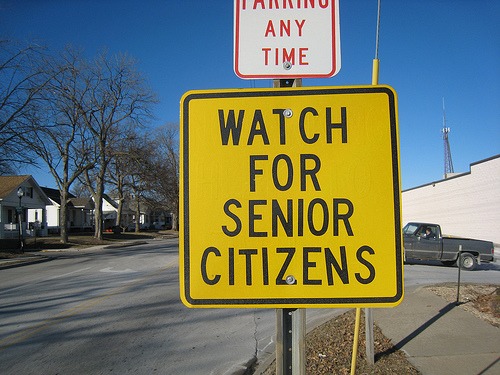Tom McNamara, Blueprint America

America is on the brink of a massive demographic shift as the first of the baby boom turned 65 this New Year. Already, an estimated 39 million people across the country are 65 or older — just over 13 percent of the population. By 2030, when all baby boomers will be over 65, there will be 72 million seniors — about 20 percent of the population. And our suburbs — where half of all Americans live today — will be hardest hit.
Elinor Ginzler, AARP’s Director of Livable Communities, talks to Blueprint America about how Americans can live in suburbia as they age. Already, the suburbs are a tough place to get around. Getting older won’t make it any easier.
Tom McNamara: This is one of those statistics that hits you right in the face: Roughly 7 in 10 current seniors and baby boomers live in our country’s suburbs. What does that mean to the livability — transportation access, housing options, and the ability to get to family, friends, medical care, or, even, maintain one’s independence — of suburbia as this large demographic continues to age?
Elinor Ginzler: The keys to successful living at any age are a home that is safe, affordable, comfortable, convenient and adaptable to changing family needs, a community that has all the features you need, and a range of transportation choices to get where you need and want to go to engage in community life. Americans of all ages have some of these features in today’s suburbs. But, modern suburban development is auto centric. For drivers the biggest problem is congestion. People who don’t drive are dependent on family and friends to stay connected.
And, people who no longer drive need more conveniently located retail and services and/or safe and convenient ways to get where they need or want to go. Many local policymakers are only now realizing the implications of changing demographics. Suburban homeowners need to make sure that their homes that were originally built for young families won’t limit their ability to live comfortably as they age. Will the design of their home support them as they age and possibly develop limitations in mobility, sight or hearing? Those are the questions we need to start asking.
McNamara: Paint a picture of suburbia then and now. Who built the suburbs? What’s happened to them and their children? What’s happened to them?
Ginzler: American suburbs began cropping up in the second half of the 19th century. But what most of us think of as the suburbs sprang up in the post World War Two era. The availability of long-term home mortgages for returning G.I.s, the affordability of family cars and the construction of the Interstate Highway System enabled young couples with families to move away from Main Streets and core city neighborhoods. Developers built large communities of detached, single-family homes with large lots on cheap land made accessible by highways and new local road projects. However, as time passed, these homes grew farther and farther from the core city where most of the jobs remained.
Baby Boomers grew up in the suburbs and most of them still live there. Some of them even moved their older parents nearby as they have gotten older. They are increasingly facing challenges in staying connected and engaged in their communities that have been designed so that people live in one area, work in another area and shop in still another area. For people who stop driving, this leaves them literally stranded without options in their homes.
McNamara: What’s the identity of the suburbs today in American culture, in the context to the age wave?
Ginzler: For many Americans, the contemporary suburb is still the preferred living arrangement. Privacy, large lots, few public safety concerns and good schools make it a destination of choice. However, the American suburban population is aging. Some are choosing redeveloped inner ring suburbs or downtown living to be closer to where the action is. Add to that the increasing cost of gas to fuel our cars and it is clear that the “Loop-and-Lollipop” cul-de-sac neighborhoods of the 20th Century face significant challenges…
Though, many local governments are trying to reinvent themselves. Without some changes to their communities, many older non-driving suburbanites risk being stuck in their homes. (The average American man will outlive his driving years by 7 years and the average older woman by 10 years.)
McNamara: So, what needs to be done to ready suburbia for the age wave? What can government — local, state, federal — do to help the aging? What kind of investment needs to be made?
Ginzler: The future of suburbia is starting to take shape: shopping malls, strip malls and other commercial centers are beginning to remake themselves into mixed use, walkable centers with multifamily housing (apartments and condos). Many older adults aging in their current homes are taking advantage of services and culture in these new town centers. Others are opting to leave the maintenance and yard work behind and move into multifamily housing.
Communities that hope to meet the mobility needs of older residents are introducing transit service routes that connect older adults to grocery stores, pharmacies, libraries and other important destinations. Volunteer driver programs, taxi voucher programs, church and community-sponsored transportation and family and friends are helping older Americans overcome the mobility barriers of today’s car-dependent suburbia.
Local governments would be well served to look at the friendliness of their walking environment in their communities. Simply improving sidewalks and changing the timing on crosswalks can mean the difference between keeping people stuck at home and creating an environment that supports healthy aging.
Meanwhile, as local governments plan for the future many are developing plans for transit-oriented developments that cluster housing, services, retail and entertainment around transit hubs — either bus or light rail. State and local governments are encouraging (by regulation or incentives) builders to develop homes that have at least one no-step entrance, wider doorways, a full bath and a room that could be used as a bedroom on the main floor. They are also increasingly adopting Complete Streets policies to upgrade our streets for all users: drivers, pedestrians, transit-users and cyclists.
McNamara: How much is the age-wave on the radar of policy makers in Washington? Sure, AARP is interested and spreading the word — but what about our elected officials? Does aging in the suburbs of political legs?
Ginzler: The establishment of the federal Sustainable Communities Partnership and the Sustainable Communities Act (which was introduced, but not passed in the last Congress) represent major steps in the federal government’s understanding of the wide range of challenges facing communities. The Act would advance the unprecedented collaboration among the U.S. Department of Housing and Urban Development, the Department of Transportation and the Environmental Protection Agency, which have pledged to work together taking housing, transportation, and environmental protection into account in planning and funding their programs toward the goal of promoting sustainable/livable communities. This kind of collaboration at all levels of government is needed to solve the wide range of problems facing our communities as they age. However, government also needs to ensure that issues affecting older adults are addressed.
Policymakers and their families, just as many of their constituents, are now experiencing the challenges (and rewards) of caring for a loved one, and that often alerts them to issues that properly belong in the public arena. We’ve heard personal stories from elected officials on both sides of the aisle about this. Some Members of Congress have introduced legislation to help support family caregivers. Others policymakers are caring for older loved ones and know first hand about the need for safe streets that serve everyone. They have advanced legislation making roads safer and more user-friendly for pedestrians and all drivers.
McNamara: There is a difference between policymakers knowing and acting. How much of the responsibility falls to families and children of the aging? Whether we like it or not, what are we all responsible for?
Ginzler: Families and children of aging parents are on the front lines and are most often the ones to step in and help take care of their loved ones. Remember that there are 44 million people in the US today taking care of older family members and friends. That represents over 75 percent of the long term care support provided to older people. Family and friends take on everything from navigating the healthcare system to finding services (including transportation and homecare), even feeding and dressing their loved ones, taking them to the doctor, paying for care, or having their loved ones move in with them. Most family caregivers give this help because, they say, that’s just what families do.
McNamara: Is there a political response?
Ginzler: Policymakers can help support family caregivers in their caregiving role by helping to make sure families can access information about services and other resources for their loved ones; that respite care, counseling, training, and other supports are available to caregivers; and by supporting other policies that help support family caregivers, such as the Community Living Assistance Services and Supports (CLASS) Program.
McNamara: What does the future hold for families of the aging?
Ginzler: Boomers can help their parents today (and themselves when they become care recipients) by talking with their loved ones early and repeatedly about where and how their folks want to live in the future, what their wishes are if they are ill, and where to find information about their finances and health care if they are suddenly unable to care for themselves. AARP’s book, Caring for Your Parents, has advice on how to have these important family conversations. Check it out.



